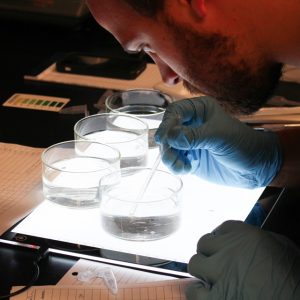Study Finds UV Exposure Late in Mahi-Mahi Embryo Development Enhances Oil Toxicity
– JULY 18, 2017
Researchers conducted laboratory experiments on mahi-mahi embryos to determine the effects of ultraviolet radiation (UV) and oil co-exposure during different times in their development. The team observed that UV affected the success of mahi-mahi hatch in all exposure scenarios compared to controls but was highest (a 1.6- to 6-fold increase) when co-exposure occurred late in embryonic development. Co-exposure with weathered surface oil reduced heart rate in hatched larvae. The results suggest that the developmental window when co-exposure occurs may affect the degree of oil toxicity and exacerbate cardiac effects in developing fish. The researchers published their findings in Environmental Toxicology and Chemistry: Exposure to ultraviolet radiation late in development increases the toxicity of oil to mahi-mahi (Coryphaena hippurus) embryos.
The Deepwater Horizon oil spill overlapped with the spawning of many pelagic Gulf of Mexico fish species including mahi-mahi, an ecologically and economically important sport fish. “Oil on its own is toxic to fish,” explained study authors Aaron Roberts and Lauren Sweet. “However, other stressors found in the fish’s environment such as ultraviolet radiation can enhance the toxicity of oil several fold. Because these embryos are found in surface waters, it’s likely that they were exposed to both UV and PAHs [polycyclic aromatic hydrocarbons] during the spill. If we do not account for the effects of these secondary stressors, we may underestimate the effects that oil has on aquatic ecosystems.”
Previous research done under the Natural Resource Damage Assessment demonstrated that PAH compounds negatively affected cardiac function and morphological development in mahi-mahi embryos and reduced swim velocity in juveniles. The studies also suggested that natural UV light increases PAH toxicity to mahi-mahi embryos 5-fold during the first 48 hours of development. “UV light damages aquatic organisms in much the same way that people get sunburns,” explained Roberts and Sweet. “While we wear sunscreen to prevent getting a sunburn, oil acts as an ‘anti-sunscreen’ and causes more damage.”
Exposure trials used varying concentrations of high-energy water accommodated fractions (HEWAFs) for Macondo source oil and weathered oil from skimming operations. Roberts explained that the dose concentrations of naturally weathered surface oil (10μg/L) was within the range of concentrations reported during the spill (0 – 84μg/L; Diercks et al., 2010) and similar to previous NRDA-sponsored work (Alloy et al., 2016, 2017). Dose concentrations for source oil were higher, because oil had not undergone weathering, and ranged from 4.5-29ug/L. Following UV and oil exposure, the researchers documented the number of alive and dead embryos and larvae to quantify hatching success and filmed embryos exposed to surface oil to quantify heart rate.
“Interestingly, this period of sensitivity late in development coincides with dramatic changes in their physiology that may contribute to this sensitivity, such as changes in buoyancy, metabolic rate, and yolk sac depletion,” explained Roberts. “Taken together, these data suggest that pelagic fish embryos are more sensitive to oil just prior to hatch.” The researchers note that future work is necessary to better understand the extent of late-development UV exposure cardiac dysfunction and cardiac-independent deformities.
Data are publicly available through the Gulf of Mexico Research Initiative Information & Data Cooperative (GRIIDC) at doi:10.7266/N7JH3J60.
The study’s authors are Lauren E. Sweet, Jason Magnuson, T. Ross Garner, Matthew M. Alloy, John D. Stieglitz, Daniel Benetti, Martin Grosell, and Aaron P. Roberts.
************
This research was made possible in part by a grant from the Gulf of Mexico Research Initiative (GoMRI) to the Relationship of Effects of Cardiac Outcomes in Fish for Validation of Ecological Risk (RECOVER) consortium.
The Gulf of Mexico Research Initiative (GoMRI) is a 10-year independent research program established to study the effect, and the potential associated impact, of hydrocarbon releases on the environment and public health, as well as to develop improved spill mitigation, oil detection, characterization and remediation technologies. An independent and academic 20-member Research Board makes the funding and research direction decisions to ensure the intellectual quality, effectiveness and academic independence of the GoMRI research. All research data, findings and publications will be made publicly available. The program was established through a $500 million financial commitment from BP. For more information, visit https://gulfresearchinitiative.org/.
© Copyright 2010-2017 Gulf of Mexico Research Initiative (GoMRI) – All Rights Reserved. Redistribution is encouraged with acknowledgement to the Gulf of Mexico Research Initiative (GoMRI). Please credit images and/or videos as done in each article. Questions? Contact web-content editor Nilde “Maggie” Dannreuther, Northern Gulf Institute, Mississippi State University (maggied@ngi.msstate.edu).






